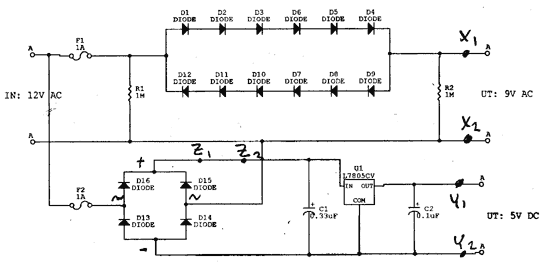Today, I found his notes. The basis of his design is a ready made 220V to 12V AC, 1-2A transformer, which costs about 70 SEK (8.50 USD) in the electronics store.When it comes to power supplies, a friend of mine tried to design a C64 power supply last year, but only on paper.

My friend comments his design:
Any constructive comments? Please don't make this a flame thread, comparing to any previous "designs" people are not satisfied with. While at the moment I'm not likely to build this kind of power supply, it would be interesting to hear if my friend was thinking in the right direction. The hardest part, to convert a high voltage to 12V would already be solved.We use simple rectifier diodes since they have good characteristics, are cheap and handle heat and cold well. The forward voltage UF is used to convert 12V AC to 9V AC, on behalf that the sinus wave gets somewhat cut off at the 0V level.
The fuses (F1, F2) should be installed on the input side, like the diagram shows. Do not use the inputs like outputs and vice versa.
The resistors (R1, R2) have two functions: together they will work as ESD protection for the diodes. This use is not crucial as rectifier diodes are quite robust and "usually" will survive anyway. The resistor on the output (R2) limits the idle voltage, without it the output voltage will equal or be very, very close to the input voltage when the adapter is completely unloaded.
Between X1 - X2 and Y1 - Y2, two small LEDs |>|´ can be mounted to indicate power function:
X1 -- | 1.2 kOhm | -- |>|´ -- X2
Y1 -- | 470 Ohm | -- |>|´ -- Y2
Between Z1 - Z2, another rectifier diode can be monted to reduce the heat in the heat sink mounted at U1.
Diodes: BY255 or other rectifier diode which can handle IF >= 2.0A with the following forward drop:
UF = 0.8V at IF = 1.0A, UF = 0.6V at IF = 0.1A
The diodes can be mounted in standing position to take less space, preferrably raised a bit from the circuit board. The outer case will not need ventilation holes if the diodes are soldered onto a circuit board.
R1, R2: Resistors 1Mohm
F1, F2: Fuses 1A (he doesn't specify closer than that)
C1, C2: Electrolytic capacitors 0.47 uF/50V (diagram says 0.33 uF ?)
U1: Common voltage regulator 5V, e.g. L7805CV or L78S05CV.
Heat sink: Austerlitz KS29.1-37,5-E or better which handles > 15C/W
Some screws, nuts and cooling paste also required.





